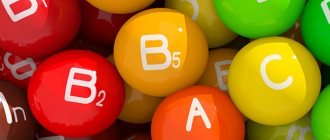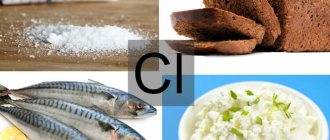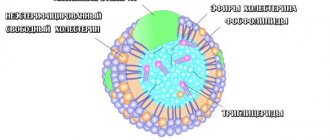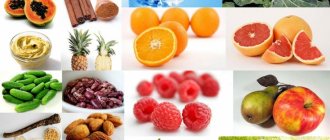The role of iron in the body
Iron is an element necessary for the body. Its most important function is participation in the construction of hemoglobin. This substance has the ability to bind oxygen particles and acts as an element that transports it to tissues in red blood cells. It also removes some of the CO2 from the circuit into the lungs (the rest is dissolved in the plasma). Iron deficiency causes anemia.
Iron also creates one of the main muscle proteins, myoglobin. Without these relationships, it is impossible to maintain muscle mass and proper functioning of the motor system.
Excess iron in the body
Excess iron in the body does not coincide with its increased level in the blood. A test of iron levels and the protein associated with iron absorption, ferritin, shows how high the iron concentration is during the test. This level may be increased, for example, due to a temporary increase in the breakdown of red blood cells or increased iron availability due to a change in diet.
However, if its levels in the body are too high, these results are accompanied by increased levels of transferrin protein and increased saturation of this compound with iron.
Causes of secondary excess iron in the body
The causes of secondary iron excess associated with body disorders are:
- increased hemolysis of blood cells (for example, after multiple transfusions)
- too much iron in the diet, medications, or supplements
- steatosis or viral hepatitis
- chronic pancreatitis
- cystic fibrosis
- alcoholic illness
- some forms of leukemia or myelodysplastic syndromes
This may be the introduction of certain medications (for example, antibiotics - chloramphenicol) or intoxication with heavy metals (for example, lead, zinc).
Primary causes of excess iron in the body
The primary cause of excess iron deposition in the body is a genetic defect. This causes increased absorption of iron from the gastrointestinal tract and accumulation of this metal in the tissues of various organs.
The disease is inherited in an autosomal recessive manner, which means that you must receive the altered gene from each parent, and it is located on the X or Y chromosomes.
Hemochromatosis genes are relatively common - on average one person per hundred (1%) of the population. Although this disorder is not sex chromosome related, it is definitely more common in men.
Nutrition at low and high levels
The level of iron in a person’s blood is greatly influenced by nutrition, and by consuming certain foods, you can adjust the content of this element.
An elevated level of iron in the blood may be a sign of the following pathologies:
- Various anemias - thalassemia, hemolytic, folate deficiency, aplastic and so on.
- Hemochromatosis is excessive absorption of iron in the gastrointestinal tract.
- Hemosiderosis - develops with frequent blood transfusions, overdose of iron-containing drugs.
- Disturbances in the process of hematopoiesis in the bone marrow.
- Liver damage.
A deficiency of an element in the body may have the following reasons:
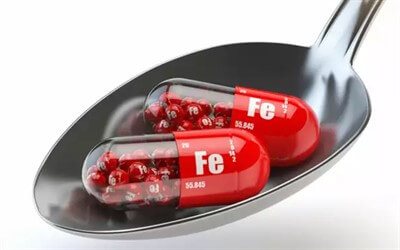
- Cirrhosis of the liver.
- Stagnation of bile.
- Iron-deficiency anemia.
- Nephrotic syndrome.
- Prolonged bleeding.
- High need for iron.
- Excessive accumulation of hemosiderin.
- Manifestation of chronic renal failure.
- Lack of ascorbic acid in the diet.
- Nutritional deficiency – an element is not supplied or is supplied with food in insufficient quantities.
- Vapor distribution deficiency due to osteomyelitis, rapidly growing tumor, inflammatory processes, heart attack, rheumatism.
Symptoms of excess iron in the body
A symptom of excess iron , both primary and secondary, is sideroblastic anemia. It causes weakness, dizziness, scarred eyes, pale skin, fatigue and difficulty breathing after exercise. If the cause of such anemia is temporary, the symptoms subside quite quickly and do not require special treatment.
Treatment of primary changes includes the administration of vitamin B6. If hemochromatosis is secondary, chelating agents are administered (that is, they bind iron into complexes, which are then excreted from the body). To compensate for the patient's condition, blood transfusions are usually given.
Chronic excess of iron in the body causes sequential deposition of this element in the tissues of various organs. Because the process is progressive, the clinical picture develops slowly - the first significant symptoms usually appear in people aged 40-50 years.
The most noticeable changes concern the skin - it acquires a gray-brown, sometimes even graphite, metallic tint. This is due not only to iron deposition in the skin, but also to damage to the pituitary gland due to overproduction of melanin.
Diet
General nutritional rules for raising iron levels in the blood:
- Meals should be fractional - in small portions, but 6 times a day.
- Food should be warm - not cold, not hot.
- The diet should include microelements that help the absorption of iron - copper, cobalt, manganese, zinc.
- Iron is better absorbed with sufficient levels of vitamin C.
- Preference should be given to protein, as it contains easily digestible iron.
- It is better to steam, bake or stew food; frying is strictly not recommended.
- It is necessary to limit fatty foods - they impair the absorption of iron.
- You should reduce your intake of foods containing calcium or maintain an interval between consuming calcium-containing foods and foods containing iron.
Regarding nutrition with high iron content, it is recommended:
- Give up meat and eat plant foods. The human body does not absorb iron from plant foods well, therefore, less building material is supplied for hemoglobin synthesis.
- Subject all dishes to long-term heat treatment.
For women and men over 50
If iron levels are low, Table-1 is recommended; nutritionists recommend the following to increase iron in the body of people over 50 years of age :

- lean meats;
- beef liver;
- poultry liver;
- low-fat fish;
- seaweed;
- cauliflower, beets, carrots;
- nuts.
- gooseberries, cranberries, currants;
- apples, pomegranates, oranges, cherries;
- low-fat dairy products - cottage cheese, sour cream, kefir;
The following should be excluded from the diet:
- fatty foods;
- mayonnaise;
- strong tea, coffee, alcohol;
- chocolate;
- sweet carbonated drinks.
Mainly plant foods reduce hemoglobin levels:
- all types of cereals;
- legumes;
- low-fat dairy products;
- fresh vegetables;
- grapes, bananas, strawberries;
- Lean meat or fish should be included in your diet twice a week.
Excess iron in the body
The human body is a very complex system that only works fully with the correct balance of elements. A person receives almost all vitamins and microelements from food and water. Some of them do not stay in the body and are excreted daily, and some have the ability to accumulate. Iron is one of the most abundant elements in nature, and it can be stored in the liver and pancreas. Everyone knows about the danger of a lack of iron in the blood - low hemoglobin, which causes anemia and even fainting. At the same time, few people think that an excess of iron is just as harmful as its deficiency.opentheme.ru
There is a disease caused by excessive iron in the blood. It is called hemochromatosis, and is often hereditary. With this disease, the absorption of iron by the body is impaired, the element accumulates in the tissues, poisoning them from the inside. People with metabolic disorders, diabetes mellitus and other chronic diseases are susceptible to this disease. Hemochromatosis requires regular monitoring by a doctor who will prescribe medications to normalize metabolism in the body.
In other cases, excess iron is acquired, i.e. excess elements enter the body with food, water and the atmosphere.
Causes of acquired iron excess
- Excessive iron saturation of drinking water. This depends on the region of residence and the quality of filtration of the water itself, but water, in principle, can oversaturate the body with any element that it contains.
- Uncontrolled intake of large doses of iron supplements.
- Alcoholism.
- Chronic liver diseases.
- The presence of a special gene responsible for excessive accumulation of iron. Every seventh inhabitant of the planet has such a gene, and it is also inherent in the Scandinavian nation. In most cases, it is in a latent state and does not make itself felt unless provoked by bad habits.
It is almost impossible to get an excess of iron from food, since iron is well absorbed, and regular food does not contain it in such quantities as to cause illness. But you can easily get less iron.
Consequences
The consequences of overloading the body with iron are very dangerous to health. Problems with joints, heart, liver, pancreas and abnormal lipid profile appear. This chronic condition can lead to the development of diabetes mellitus or cirrhosis of the liver. An excess of this element causes hormonal imbalances and can even lead to the development of cancer. The motor system is exposed to chronic inflammation and the appearance of degenerative changes, which greatly complicates movement and also brings a lot of pain. Excess iron promotes the growth of bacteria, which can lead to dangerous complications (sepsis).
Symptoms of iron overload
There is no need to undergo tests to identify problems with iron in the body. All signs of a violation can be seen with the naked eye. You should especially be wary of:
- Yellowing of mucous membranes. The palate, sclera, and tongue acquire a yellowish tint - this is a signal of liver problems. This sign often signals jaundice and an excess of iron.
- Pale skin, apathy.
- Heart rhythm disturbance.
- The presence of pigment spots on the hollows and inner sides of the limbs.
General recommendations for food consumption
Products are best subject to short heat treatment
There are some foods that help improve iron absorption. These include foods high in vitamin C:
- citrus juices;
- onions and greens;
- rose hip;
- broccoli;
- sea buckthorn;
- bell pepper;
- fruits.
Products that contain vitamin B, manganese, and copper also have a good effect. These substances can be found in the following products:
- turnips and beets;
- cottage cheese;
- currant;
- lettuce and parsley;
- spinach;
- milk;
- radish;
- gooseberry;
- hazelnut;
- sesame.
It is necessary to include in the diet foods containing zinc:
- eggs;
- beef;
- yeast.
Products containing sulfur:
- cabbage;
- onion;
- garlic.
Folic acid is also suitable, which is:
- avocado;
- asparagus;
- apricots;
- kiwi;
- strawberries;
- grenade;
- raspberries;
- barley;
- corn;
- oatmeal;
- rice.
To prevent your body from suffering from iron deficiency, you need to eat a varied diet of high-quality foods.
The absorption of iron is facilitated by succinic acid, which is found in sunflower seeds, rye bread, grapes, and cherries.
Phytin, which is found in whole grain flour, bran (but soaking them reduces the amount of this acid), and vitamin E are not recommended, since it forms poorly soluble compounds with iron.
It is also important to know about those foods that interfere with the normal absorption of microelements. Thus, it is not recommended to combine fatty foods and milk, which contains calcium, with iron-containing foods. This element does not allow for good absorption of iron. If you cannot limit the amount of such products, then try to take them separately from those containing iron.
In addition, you should not drink coffee or tea, because they contain a substance called tannin. This substance reduces iron content by as much as 60%. Cereals are also not suitable, because they are poorly digested, iron is fixed on them, as a result of which it is excreted from the body.
Another tip is to use cast iron cookware for cooking, since during such heat treatment, beneficial substances are preserved. When cooked in another container or when frozen, the absorption of the microelement is reduced.
Read: Recommendations on how to prepare rolled oat flakes, basic information about their beneficial qualities and calorie content
If a person has problems with the absorption of this microelement, then you need to consult a doctor. He will prescribe special medications.
Excess iron
Excess iron is a very serious and common problem caused by excess iron in the body.
Iron is one of the most common chemical elements in nature and, naturally, an essential trace element for the human body. The human body contains approximately 3.5 to 4.5 grams of iron. 2/3 are in the blood, 1/3 in the liver, bone marrow, muscles and spleen.
Iron performs many functions in our body:
- supports the functioning of the immune system;
- participates in the transport of oxygen throughout the body;
- neutralizes toxic substances entering the body;
- participates in the formation of enzymes and red blood cells;
- supports the synthesis of thyroid hormones;
- important for good condition of skin, nails and hair;
- participates in regeneration processes in the body.
Table with foods that reduce and increase Fe
| № | Increases iron levels | Lower iron levels |
| 1 | Meat and offal - beef, pork, lamb, turkey, chicken, liver. The darker the meat, the more iron it contains | Rice cereal |
| 2 | Fish and seafood – mussels, oysters, tuna, shrimp, sardines, red and black caviar | Dairy and fermented milk products |
| 3 | Eggs – quail, chicken | Products that do not contain vitamin C and B |
| 4 | Cereals – buckwheat, oatmeal, rye, wheat bran, barley groats | River fish |
| 5 | Vegetables and greens – spinach, broccoli, beets, cauliflower, asparagus, corn | Coffee |
| 6 | Legumes – lentils, peas, beans | Black and green tea |
| 7 | Fruits and berries – apples, dogwoods, pomegranates, persimmons, plums | Chicken's meat |
| 8 | Dried fruits – figs, raisins, dried apricots, prunes | Vegetables and fruits, excluding red and orange |
| 9 | Nuts - all types |
Causes of excess iron in the body
Factors that lead to excess iron in the body:
- Iron content in drinking water;
- Oxygen starvation caused by large amounts of exhaust gases in cities. In the body, the lack of oxygen is compensated by an increase in hemoglobin production;
- Taking large amounts or a long time of iron supplements;
- Alcoholism;
- Receiving several blood transfusions;
- The presence in the body of a gene that causes the body to accumulate iron (it is also called the “Celtic gene”, since its presence is mainly observed in the inhabitants of Scandinavia). It is present in 15% of people, but in most it is dormant.
The daily dose of iron is very approximate. The absorption of this microelement largely depends on the condition of the body, to determine which it is necessary to do blood tests. The approximate daily iron requirement for women is 18 mg, for men – 10 mg. The highest daily iron requirement for pregnant women in the second half of pregnancy is 33 mg.
Sample menu
To increase iron in the blood, you should start your morning with a glass of water.
Sample menu for the day:
- Breakfast: buckwheat, pre-soaked in kefir with the addition of fruit.
- Lunch: rare steak and salad with greens and boiled beans, dressed with lemon juice and olive oil.
- Afternoon snack: fruit salad or fresh beets with carrots.
- Dinner: fish baked in foil with a green salad with green peas, dressed with lemon juice and olive oil.
It is recommended to drink rosehip infusion during the day, and it is better to replace coffee and tea with chicory during the diet. This drink will give you energy and strengthen your immune system.
A diet for high hemoglobin will give results in just a couple of weeks, the main thing is to follow it strictly. The menu can be arranged according to the list of permitted products.
Sample daily menu for reducing iron in the blood:
- Breakfast: fruit salad – seedless grapes, kiwi, apricots, banana.
- Lunch: chicken soup with rice, fish baked with vegetables in foil.
- Afternoon snack: cottage cheese casserole with raisins.
- Dinner: boiled chicken fillet with mashed potatoes or porridge.
Cranberry compote is recommended for drinks. Thanks to it, you can not only bring your hemoglobin level back to normal, but also improve your immunity.
Symptoms of excess iron
Symptoms of excess iron:
- yellow discoloration of the skin, tongue, palate and sclera;
- liver enlargement;
- itching;
- heart rhythm disturbances;
- poor general condition;
- thinness;
- pallor;
- pigmentation on the palms and places of old scars, in the armpits.
Excess iron in the body also complicates the progression of Alzheimer's and Parkinson's diseases. Even if there are symptoms of iron excess, an accurate diagnosis can only be determined after a biochemical blood test.

